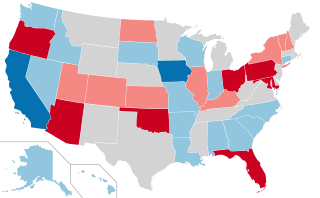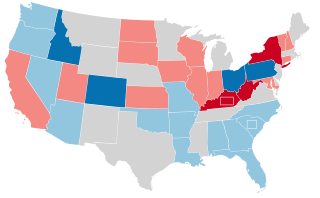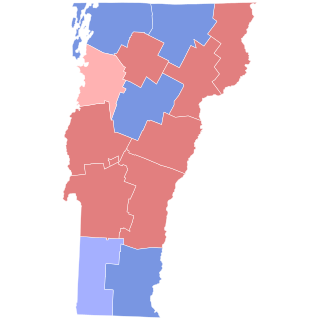
The 1968 United States Senate elections were elections for the United States Senate. Held on November 5, the 34 seats of Class 3 were contested in regular elections. They coincided with the presidential election of the same year. The Republicans picked up five net seats in the Senate. This saw Republicans win a Senate seat in Florida for the first time since Reconstruction.

The 1956 United States Senate elections were elections for the United States Senate that coincided with the re-election of President Dwight D. Eisenhower. The 32 seats of Class 3 were contested in regular elections, and three special elections were held to fill vacancies. Although Democrats gained two seats in regular elections, the Republicans gained two seats in special elections, leaving the party balance of the chamber unchanged.

The 1932 United States Senate election in Vermont took place on November 8, 1932. Republican Porter H. Dale successfully ran for re-election to another term in the United States Senate, defeating Democratic candidate Fred C. Martin. Dale died in October 1933, vacating the seat until a special election was held in January 1934.

The 1940 Vermont gubernatorial election took place on November 5, 1940. Incumbent Republican George Aiken did not run for re-election to a third term as Governor of Vermont, instead running for the United States Senate. Republican candidate William H. Wills defeated Democratic candidate John McGrath to succeed him.

The 1988 United States Senate election in Vermont took place on November 8, 1988. Incumbent Republican Robert Stafford did not run for re-election to another term in the United States Senate. Republican candidate Jim Jeffords defeated Democratic candidate Bill Gray to succeed him.

The 1982 United States Senate election in Vermont took place on November 2, 1982. Incumbent Republican Robert Stafford successfully ran for re-election to another term in the United States Senate, defeating Democratic candidate James A. Guest. This election marks the last time a Democrat won any counties in a race for Vermont's Class 1 US Senate seat, as well as the last time the winner of the seat did not win every county in the state.

The 1940 United States Senate election in Vermont took place on November 5, 1940. Incumbent Republican Warren Austin successfully ran for re-election to another term in the United States Senate, defeating Democratic candidate Ona S. Searles. Austin would resign in August 1946 to become United States Ambassador to the United Nations; Ralph Flanders was appointed to replace him and went on to win election to a full term in 1946.

The 1934 United States Senate election in Vermont took place on November 6, 1934. Incumbent Republican Warren Austin successfully ran for re-election to a full term in the United States Senate, defeating Democratic candidate Fred C. Martin. Austin was elected in a 1931 special election to replace Frank C. Partridge, who was appointed to fill the vacancy created by the death of Frank L. Greene. As of 2022, Martin's 48.37% vote share remains the largest a Democrat has ever received for Vermont's Class I Senate seat.

The 1931 United States Senate special election in Vermont took place on March 31, 1931. Republican Warren Austin was elected to the United States Senate to serve the remainder of the deceased Frank L. Greene's term, defeating Democratic candidate Stephen M. Driscoll. Austin replaced Frank C. Partridge, who was appointed to fill the seat until a special election could be held and was defeated in the special primary.

The 1928 United States Senate election in Vermont took place on November 6, 1928. Incumbent Republican Frank L. Greene successfully ran for re-election to another term in the United States Senate, defeating Democratic candidate Fred C. Martin. Greene died in December 1930 and Frank C. Partridge was appointed to fill the seat until a special election could be held in March 1931.

The 1916 United States Senate election in Vermont took place on November 7, 1916. Incumbent Republican Carroll S. Page successfully ran for re-election to another term in the United States Senate, defeating Democratic candidate Oscar C. Miller. This was the second United States Senate direct election to take place in Vermont following the ratification of the Seventeenth Amendment to the United States Constitution and the first for Vermont's Class I seat.

The 1920 United States Senate election in Vermont took place on November 2, 1920. Incumbent Republican William P. Dillingham successfully ran for re-election to another term in the United States Senate, defeating Democratic candidate Howard E. Shaw. Dillingham died in July 1923, vacating the seat until a special election could be held in November 1923.

The 1923 United States Senate special election in Vermont took place on November 6, 1923. Republican Porter H. Dale was elected to the United States Senate to serve the remainder of the deceased William P. Dillingham's term, defeating Democratic candidate Park H. Pollard.

The 1926 United States Senate election in Vermont took place on November 2, 1926. Republican Porter H. Dale successfully ran for re-election to a full term in the United States Senate, defeating Democratic candidate James E. Kennedy.

The 1938 United States Senate election in Vermont took place on November 8, 1938. Republican Ernest W. Gibson Sr. successfully ran for re-election to another term in the United States Senate, defeating Democratic candidate John McGrath. Gibson Sr. died in June 1940 and his son, Ernest W. Gibson Jr., was appointed to fill the seat until a special election could be held in November 1940.

The 1940 United States Senate special election in Vermont took place on November 5, 1940. Republican George Aiken was elected to the United States Senate to serve the remainder of the deceased Ernest W. Gibson, Sr.'s term, defeating Democratic candidate Herbert B. Comings. Aiken replaced Gibson's son, Ernest W. Gibson, Jr., who was appointed to fill the seat until a special election could be held.

The 1944 United States Senate election in Vermont took place on November 7, 1944. Incumbent Republican George Aiken ran successfully for re-election to another term in the United States Senate, defeating Democratic nominee Harry W. Witters.

The 1950 United States Senate election in Vermont took place on November 7, 1950. Incumbent Republican George Aiken ran successfully for re-election to another term in the United States Senate, defeating Democratic challenger James E. Bigelow.

The 1956 United States Senate election in Vermont took place on November 6, 1956. Incumbent Republican George Aiken ran successfully for re-election to another term in the United States Senate, defeating Democratic nominee Bernard O'Shea, editor of the Swanton Courier.

The 1968 United States Senate election in Vermont took place on November 5, 1968. Incumbent Republican George Aiken ran successfully for re-election to another term in the United States Senate; he was unopposed. As of 2023, this is the last time the Republicans won the Class 3 Senate seat in Vermont.










